As a longtime gardener, I’ve always found something magical about shrubs with white flowers. They bring a sense of calm, purity, and elegance to any garden space. Whether it’s the soft bloom of a Snowberry in early summer or the crisp petals of a Star Magnolia in spring, white-flowering shrubs have a way of standing out while still blending beautifully with every other color in the garden.
Over the years, I’ve grown and admired dozens of shrubs with white flowers, each with its own personality—some are fragrant and delicate, while others are bold and architectural. Some bloom early to signal spring’s arrival, while others linger late into the season. From native favorites like Serviceberry to ornamental choices like Snowmound Spirea, there’s a perfect white-flowering shrub for just about every climate and garden style.
In this guide, I’ll share 32 shrubs with white flowers, complete with pictures and key identification tips. If you’re planning a new landscape or looking to add brightness to an existing border, these selections offer year-round interest and are well-suited to many USDA zones across North America.
Different Types of Shrubs with White Flowers
Symphoricarpos albus (Common Snowberry)
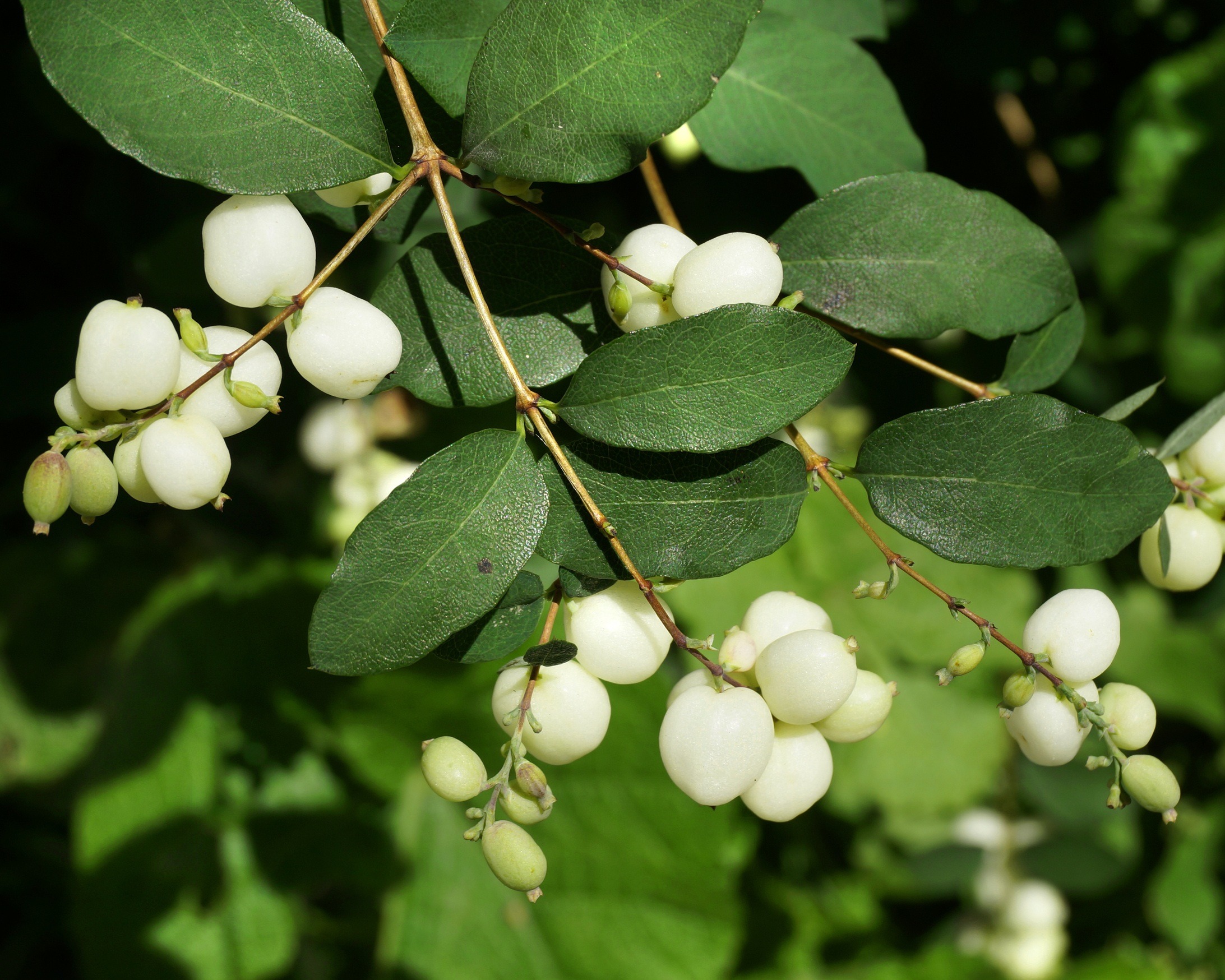
Symphoricarpos albus, known as Common Snowberry, is a deciduous shrub native to North America, particularly prevalent in the northern and western regions. It typically grows 3 to 6 feet tall and wide with thin, arching branches and soft, bluish-green leaves. The plant gets its name from the clusters of white, berry-like fruits it produces in the fall.
In late spring to early summer, the shrub blooms with small, bell-shaped white to pale pink flowers. These delicate flowers are usually tucked under the foliage and are not overly showy, but they attract bees, butterflies, and hummingbirds. The white fruits that follow persist into winter and are especially valued for wildlife.
Common Snowberry thrives in USDA hardiness zones 2 through 7. It grows well in a range of soil types including clay and sandy soils and tolerates partial shade to full sun. The plant is low-maintenance and drought-tolerant once established, making it an excellent choice for naturalistic plantings or erosion control.
Cornus sericea (Red Twig Dogwood)
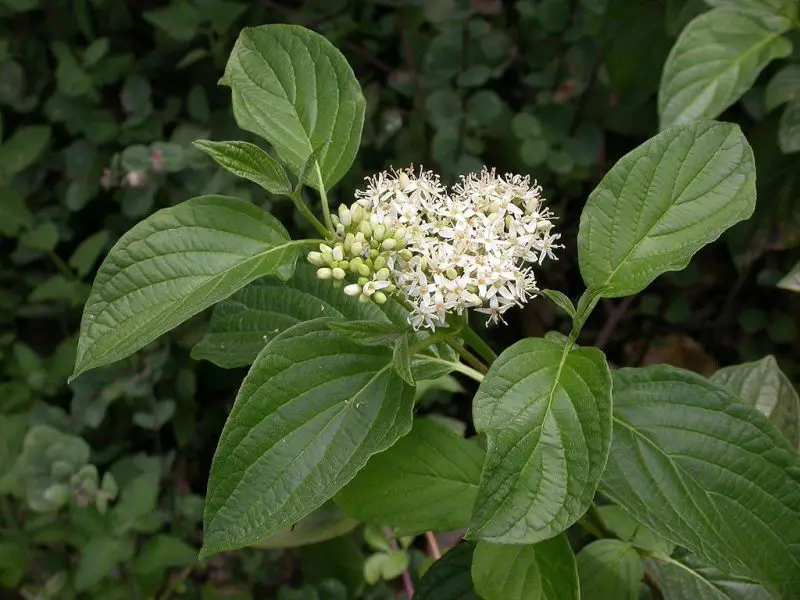
Cornus sericea, commonly called Red Twig Dogwood, is a striking deciduous shrub known for its vivid red stems in winter. Native to much of North America, it typically grows 6 to 9 feet tall and forms dense thickets. Its oval green leaves turn red or orange in fall, adding to its seasonal interest.
In late spring to early summer, it produces flat-topped clusters of small white flowers. These blooms are followed by white to bluish berries that attract birds. While the flowers are modest, the contrast of white blooms against dark green foliage makes it a valued ornamental.
Red Twig Dogwood grows well in USDA zones 2 to 7. It prefers moist, well-drained soils and full sun to partial shade. It tolerates wet areas, making it ideal for rain gardens and streambanks. Pruning older stems encourages the growth of new, brighter red shoots and helps maintain a tidy appearance.
Chionanthus virginicus (Fringe Tree)
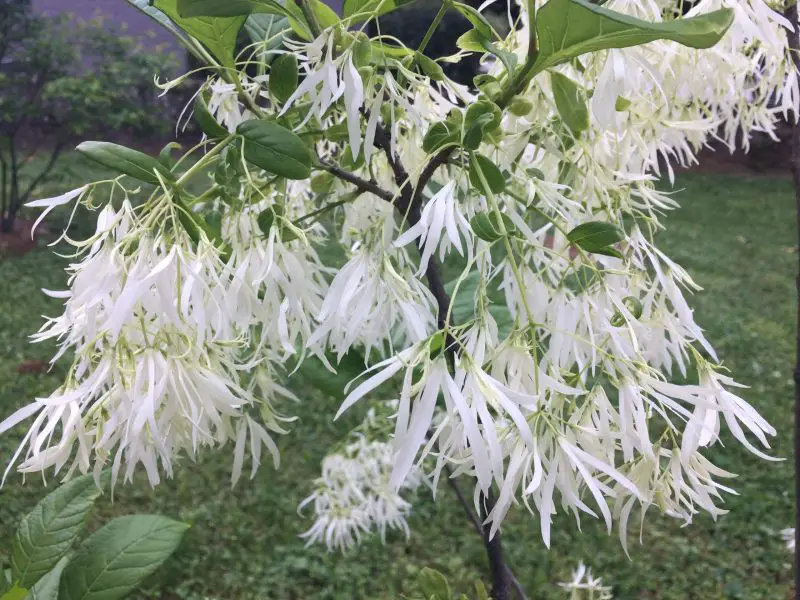
Chionanthus virginicus, also known as Fringe Tree or Old Man’s Beard, is a small deciduous shrub or tree native to the southeastern United States. It typically grows 12 to 20 feet tall with an open, rounded form. The leaves are dark green and turn yellow in the fall.
In late spring, Fringe Tree produces abundant, fragrant, white fringe-like flowers that hang in clusters, giving the plant its common name. These flowers are showy and attract pollinators. Female plants may also produce dark blue fruits in late summer if a male plant is nearby for pollination.
This plant thrives in USDA zones 3 through 9. It prefers well-drained, fertile soils and can grow in full sun or partial shade. Fringe Tree requires little maintenance once established and benefits from occasional pruning to shape or remove damaged branches.
Itea virginica ‘Little Henry’ (Virginia Sweetspire)
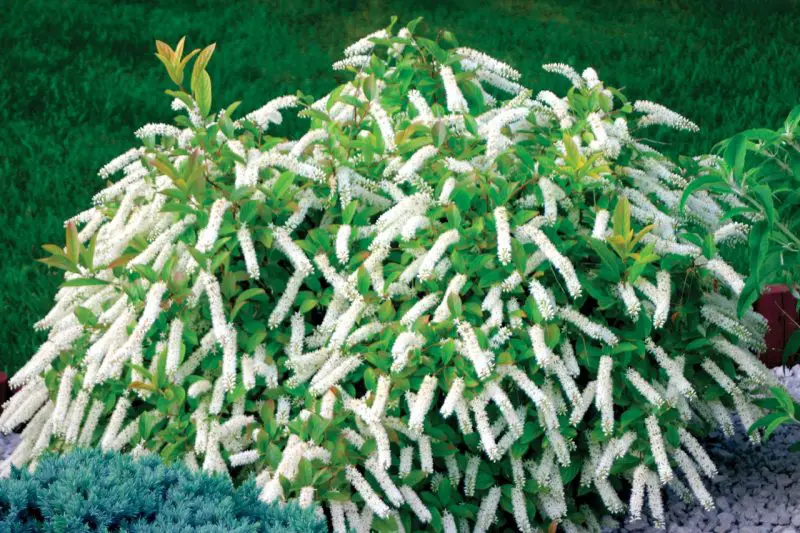
Itea virginica ‘Little Henry’ is a compact cultivar of Virginia Sweetspire, native to the southeastern United States. This deciduous shrub reaches about 2 to 3 feet tall and spreads up to 4 feet wide, making it ideal for smaller landscapes or mass plantings. It has glossy green leaves that turn brilliant shades of red, orange, and purple in the fall.
In late spring to early summer, the shrub is covered in slender, drooping racemes of fragrant white flowers. These blooms attract bees and butterflies and create a soft, cascading appearance that adds movement and texture to garden beds.
This plant is hardy in USDA zones 5 through 9. It grows best in moist, well-drained soil and can tolerate both full sun and partial shade. It is also tolerant of wet conditions and is a great option for rain gardens, woodland borders, or naturalized plantings.
Aronia melanocarpa ‘Brilliantissima’ (Black Chokeberry)

Aronia melanocarpa ‘Brilliantissima’, a cultivar of Black Chokeberry, is a native North American shrub valued for its multi-season interest. It typically grows 3 to 6 feet tall and wide with a dense, upright habit. The glossy green foliage turns vibrant red in fall, and black berries persist well into winter.
White, five-petaled flowers bloom in clusters during late spring, providing a fresh contrast against the dark green leaves. These blossoms attract pollinators and are followed by shiny black berries that are edible though quite tart, often used in jams and juices.
Black Chokeberry thrives in USDA zones 3 through 8. It adapts well to various soil types and grows in full sun to partial shade. It is low-maintenance, drought-tolerant once established, and useful in hedgerows, wildlife gardens, or erosion-prone areas.
Hydrangea arborescens (Smooth Hydrangea)
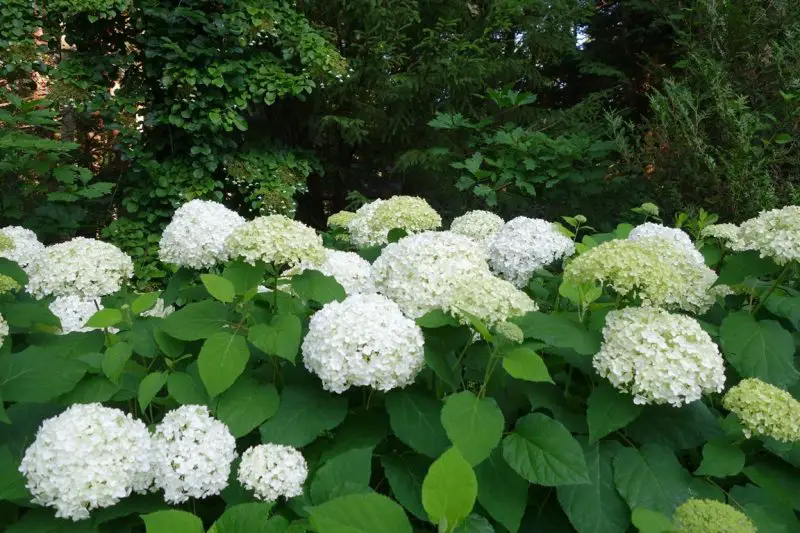
Hydrangea arborescens, commonly known as Smooth Hydrangea, is a deciduous shrub native to the eastern United States. It typically grows 3 to 5 feet tall and wide, with dark green, serrated leaves that provide an attractive backdrop to its showy flowers. This hydrangea species has a rounded, dense form that makes it perfect for borders and as a foundation plant.
In late spring to summer, Smooth Hydrangea produces large, spherical clusters of white or creamy flowers, sometimes turning a light pink as they mature. The flowers are often 4 to 6 inches in diameter and attract pollinators like bees and butterflies. Some cultivars, like ‘Annabelle’, are particularly known for their large flower heads.
Hardy in USDA zones 3 through 9, this shrub thrives in moist, well-drained soils and prefers partial to full sun. It is relatively low-maintenance, requiring pruning in early spring to maintain a compact shape and promote healthy blooms. Smooth Hydrangea is known for its ability to tolerate a variety of soil types, including clay.
Philadelphus coronarius (Mock Orange)
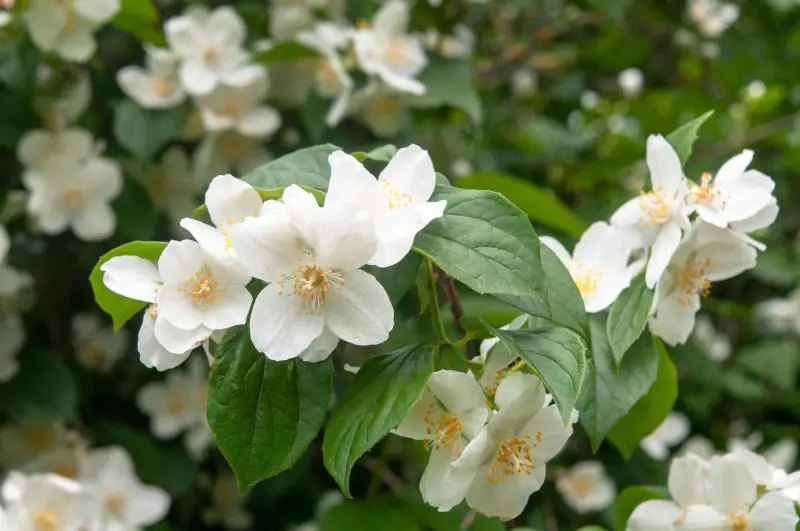
Philadelphus coronarius, also known as Mock Orange, is a deciduous shrub native to southern Europe and parts of Asia. It typically reaches 6 to 10 feet in height, with dense, arching branches and dark green, opposite, ovate leaves. The foliage has a fresh, citrus-like scent when crushed, which adds to the overall appeal of the shrub.
In late spring to early summer, Mock Orange produces an abundance of white, four-petaled flowers, each with a delightful fragrance that resembles orange blossoms. The flowers are arranged in loose clusters and attract a wide variety of pollinators, including bees and butterflies. After flowering, it often produces small, brown seed capsules.
Hardy in USDA zones 4 through 8, Philadelphus coronarius thrives in well-drained, slightly acidic soils and does best in full sun to partial shade. This shrub is fairly low-maintenance, requiring only minimal pruning after flowering to keep its shape. It can also tolerate drought once established, making it an excellent choice for xeriscaping.
Spiraea alba (White Meadowsweet)
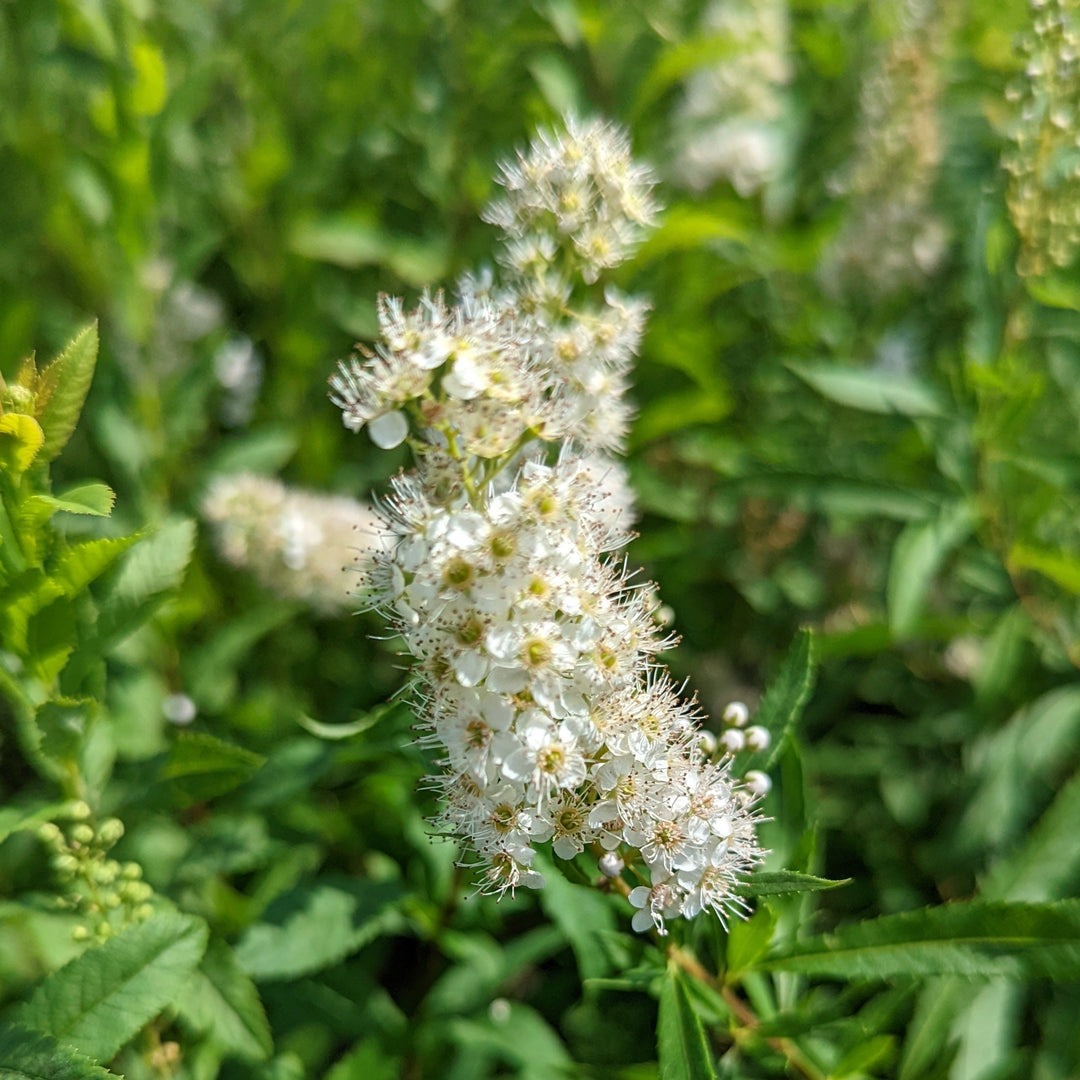
Spiraea alba, commonly known as White Meadowsweet, is a deciduous shrub native to North America, typically found in wetlands and along streambanks. It grows 3 to 5 feet tall and wide, with slender, arching stems and lance-shaped green leaves that turn yellow in the fall. Its loose, airy habit makes it a great addition to naturalized areas.
In mid to late summer, White Meadowsweet produces large clusters of small, white flowers that cover the shrub in a frothy display. The flowers attract pollinators like bees and butterflies, providing a vital nectar source during the warmer months. Its distinctive white blooms stand out against its green foliage, adding brightness to the landscape.
Hardy in USDA zones 3 through 9, Spiraea alba thrives in moist, well-drained soils and full sun to partial shade. It is a low-maintenance shrub that tolerates wet conditions and occasional drought once established. Pruning after flowering helps maintain its shape and encourages dense growth.
Ceanothus americanus (New Jersey Tea)
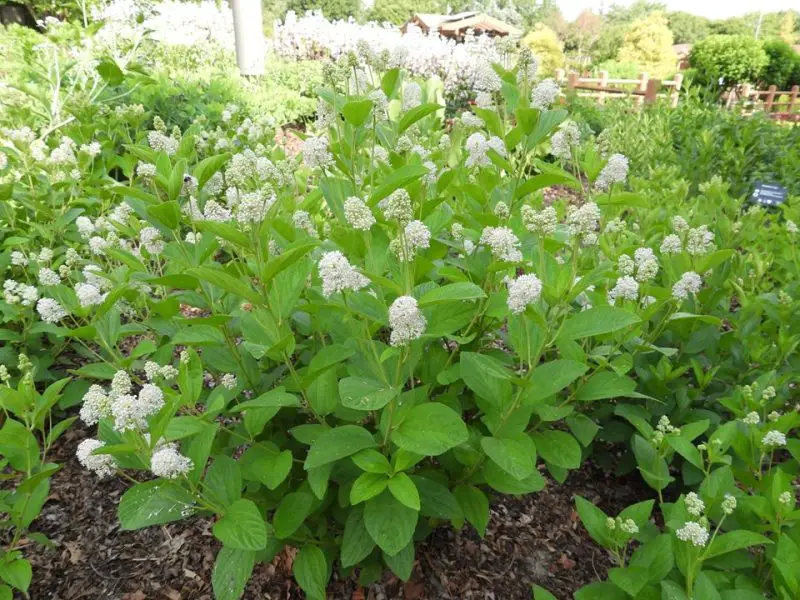
Ceanothus americanus, known as New Jersey Tea, is a deciduous shrub native to eastern North America. It typically grows 3 to 4 feet tall and wide, with dark green, leathery leaves and a dense, rounded form. Its compact size makes it ideal for borders, groundcovers, or woodland edges.
In late spring to early summer, New Jersey Tea produces clusters of small, fragrant white flowers that resemble those of the tea plant. The blooms attract pollinators, especially bees and butterflies, and can provide an essential nectar source in the garden. The flowers are followed by small, brown seed pods that persist into fall.
Hardy in USDA zones 3 through 8, Ceanothus americanus thrives in well-drained soils and full sun. It is drought-tolerant once established and prefers slightly acidic soil. New Jersey Tea benefits from light pruning to keep its shape and to remove any dead or damaged growth. It’s an excellent choice for xeriscaping and native plant gardens.
Calycanthus floridus ‘Athens’ (White Sweetshrub)
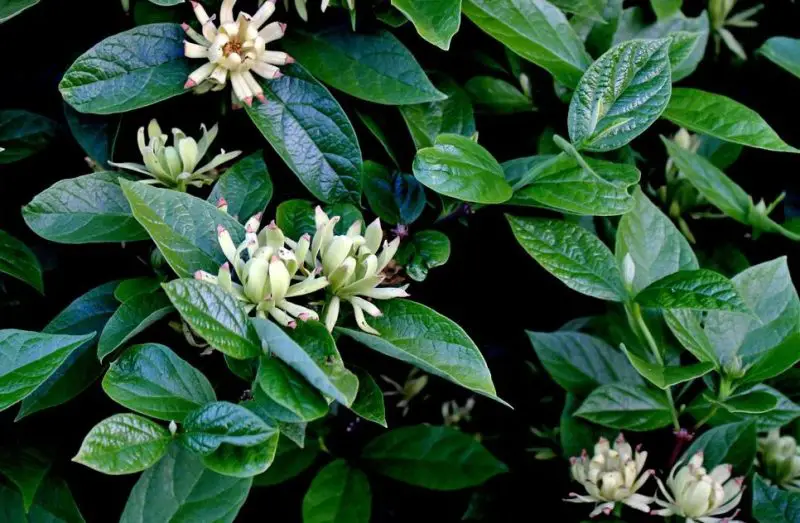
Calycanthus floridus ‘Athens’, known as White Sweetshrub, is a cultivar of the native Calycanthus floridus, prized for its fragrant white flowers. This deciduous shrub typically grows 5 to 6 feet tall with an arching habit, and its broad, glossy green leaves are aromatic when crushed, adding a layer of sensory interest to the landscape.
The White Sweetshrub blooms in late spring to early summer, producing large, creamy white flowers with a strong, sweet fragrance. The flowers have a unique appearance, with multiple petals that resemble a cluster of twisted ribbons. The shrub also produces small, spherical brown fruits in late summer.
Hardy in USDA zones 5 through 9, Calycanthus floridus ‘Athens’ prefers well-drained, slightly acidic soils and thrives in full sun to partial shade. This shrub is relatively low-maintenance, requiring only occasional pruning to remove dead or damaged wood. Its fragrant flowers and attractive form make it an excellent specimen plant or addition to a shrub border.
Viburnum dentatum (Arrowwood Viburnum)

Viburnum dentatum, known as Arrowwood Viburnum, is a dense, multi-stemmed deciduous shrub native to eastern North America. It typically grows 6 to 10 feet tall and wide, with upright, arching branches and dark green, toothed leaves that turn yellow to reddish-purple in fall. Its adaptable and tough nature makes it a reliable choice for many landscapes.
In late spring to early summer, Arrowwood Viburnum produces flattened clusters of small, creamy-white flowers. These blossoms attract bees, butterflies, and other pollinators. By late summer to fall, blue-black berries appear in abundance, providing an important food source for birds and wildlife.
This shrub is hardy in USDA zones 3 through 8. It tolerates a wide variety of soils, including clay and wet sites, and thrives in both full sun and part shade. Once established, it requires minimal maintenance and is ideal for hedges, screens, and naturalistic plantings.
Viburnum lantanoides (Hobblebush)
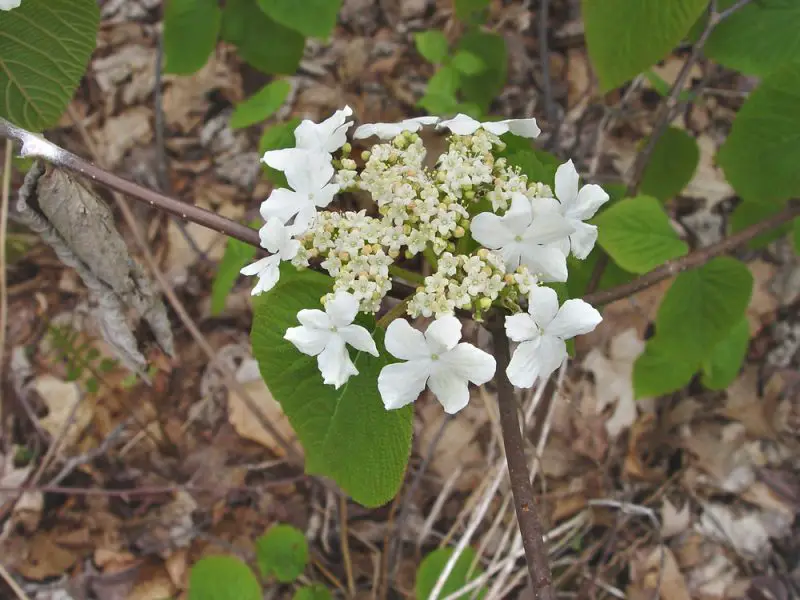
Viburnum lantanoides, commonly called Hobblebush, is a sprawling, deciduous shrub native to the northeastern United States and parts of Canada. It usually grows 6 to 12 feet tall and forms thickets as its arching branches root where they touch the ground. The large, velvety leaves are heart-shaped and turn vibrant shades of red and purple in autumn.
Blooming in mid to late spring, Hobblebush produces distinctive flat-topped flower clusters with large, sterile white flowers on the outer edge and smaller fertile flowers in the center. This unique floral structure is highly attractive to native bees and other pollinators. Clusters of red berries that mature to dark purple follow in late summer.
It is hardy in USDA zones 3 through 7 and thrives in cool, moist, acidic soils. Hobblebush prefers partial to full shade and is ideal for woodland gardens and naturalized areas. Though it requires consistent moisture, it is a low-maintenance plant that adds significant wildlife value and visual interest.
Viburnum prunifolium (Blackhaw Viburnum)

Viburnum prunifolium, or Blackhaw Viburnum, is a versatile deciduous shrub or small tree native to the eastern and central United States. It typically grows 12 to 15 feet tall, sometimes reaching up to 20 feet. The oval, finely toothed leaves are dark green through the growing season and turn reddish-purple in fall.
In mid to late spring, it produces creamy-white flower clusters that are highly fragrant and attract pollinators such as bees and butterflies. These are followed by pinkish-red fruits that ripen to a bluish-black color in late summer. The edible berries are enjoyed by birds and can be used to make preserves or jelly.
Blackhaw Viburnum is hardy in USDA zones 3 through 9. It tolerates a range of soil types and moisture conditions and grows well in full sun to partial shade. It’s an excellent low-maintenance choice for hedges, woodland edges, and multi-season ornamental value.
Viburnum opulus (European Cranberrybush)
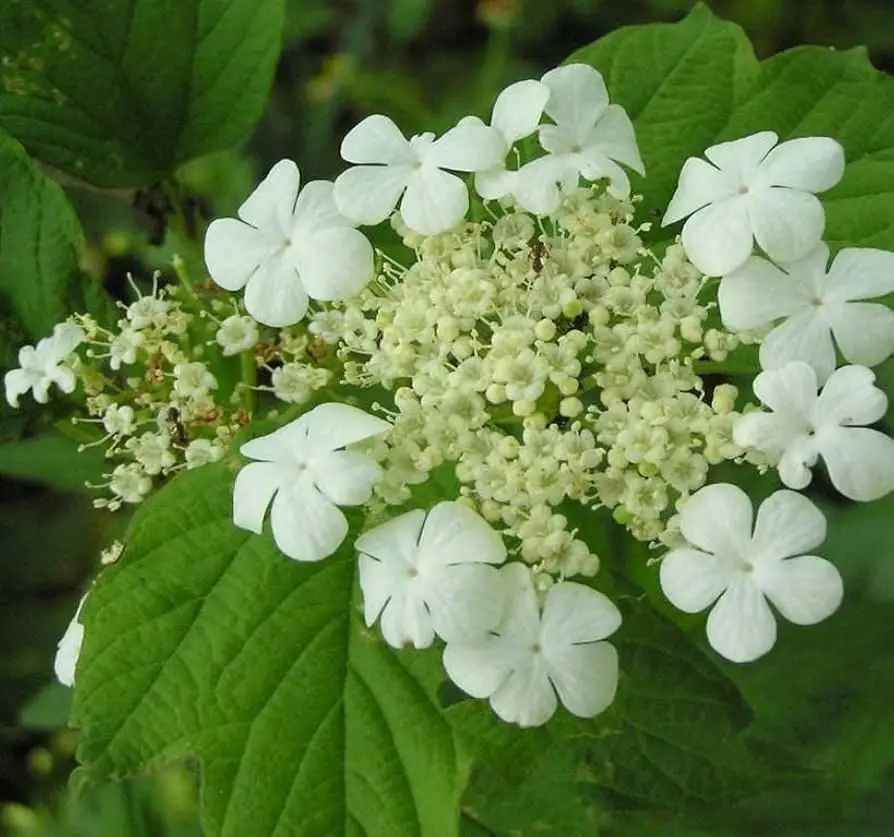
Viburnum opulus, commonly referred to as European Cranberrybush, is a large deciduous shrub valued for its showy flowers and bright berries. It grows 8 to 12 feet tall and wide with a rounded form and three-lobed, maple-like leaves that turn red or purple in autumn.
In late spring, the plant blooms with elegant white lacecap flowers—large sterile blooms encircle smaller fertile ones in the center of each cluster. These flowers are followed by translucent red berries that persist into winter, offering striking seasonal interest and food for birds.
European Cranberrybush thrives in USDA zones 3 through 8. It prefers moist, well-drained soils and full sun to partial shade. Though tolerant of wet areas, it performs best with consistent moisture. It’s an excellent choice for mixed borders, hedges, and rain gardens.
Amelanchier canadensis (Serviceberry)
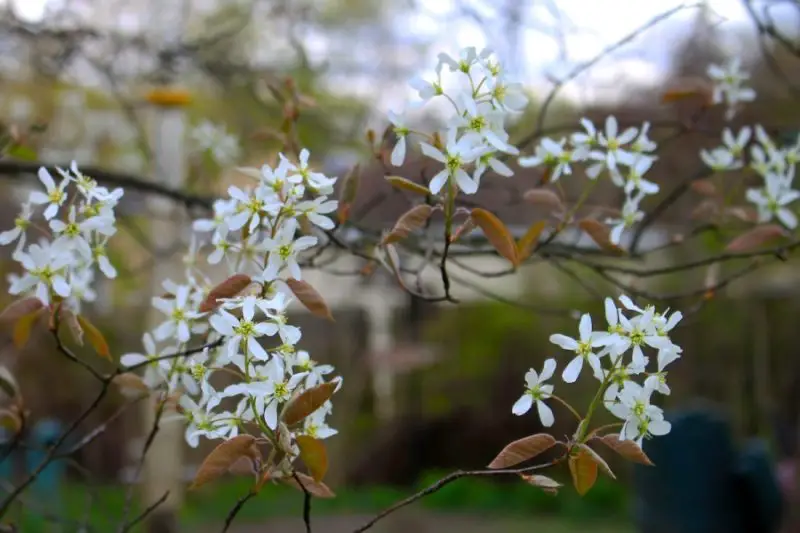
Amelanchier canadensis, known commonly as Serviceberry, is a graceful multi-stemmed shrub or small tree native to eastern North America. It typically reaches 15 to 25 feet in height, with a slender form and smooth gray bark. The leaves emerge bronzy in spring, turn green in summer, and develop vivid red-orange tones in fall.
In early spring, before the leaves fully develop, Serviceberry produces abundant clusters of small, five-petaled white flowers. These blossoms are short-lived but highly ornamental, attracting bees and early pollinators. The flowers give way to small, edible purple-black berries in early summer, which are favored by birds and also used in pies and jams.
This species is hardy in USDA zones 4 through 9 and thrives in moist, acidic, well-drained soils. It performs well in full sun to partial shade and benefits from regular watering, especially in dry periods. Serviceberry is a top choice for native gardens, understory plantings, and year-round ornamental appeal.
Clethra alnifolia (Summersweet Clethra)
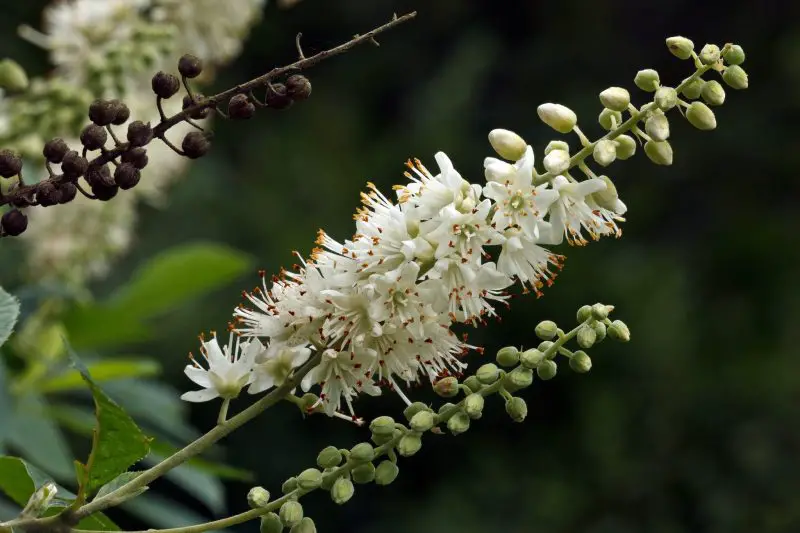
Clethra alnifolia, commonly known as Summersweet Clethra, is a deciduous shrub native to the eastern United States. It typically grows 3 to 8 feet tall with an upright, rounded form and dark green, finely serrated leaves that turn golden-yellow in fall. Its adaptability to wet soils makes it an excellent choice for rain gardens and naturalized plantings.
This shrub blooms in mid to late summer with upright spikes of fragrant white flowers that attract bees, butterflies, and hummingbirds. The blossoms are noted for their sweet, spicy scent and appear when few other shrubs are in flower, adding seasonal interest to shaded areas.
Hardy in USDA zones 4 through 9, Summersweet Clethra thrives in moist, acidic soils and partial to full shade, though it will tolerate sun with enough moisture. It requires minimal pruning and is resistant to pests and diseases, making it a low-maintenance yet rewarding addition to native gardens and wetland edges.
Fothergilla gardenii (Dwarf Fothergilla)
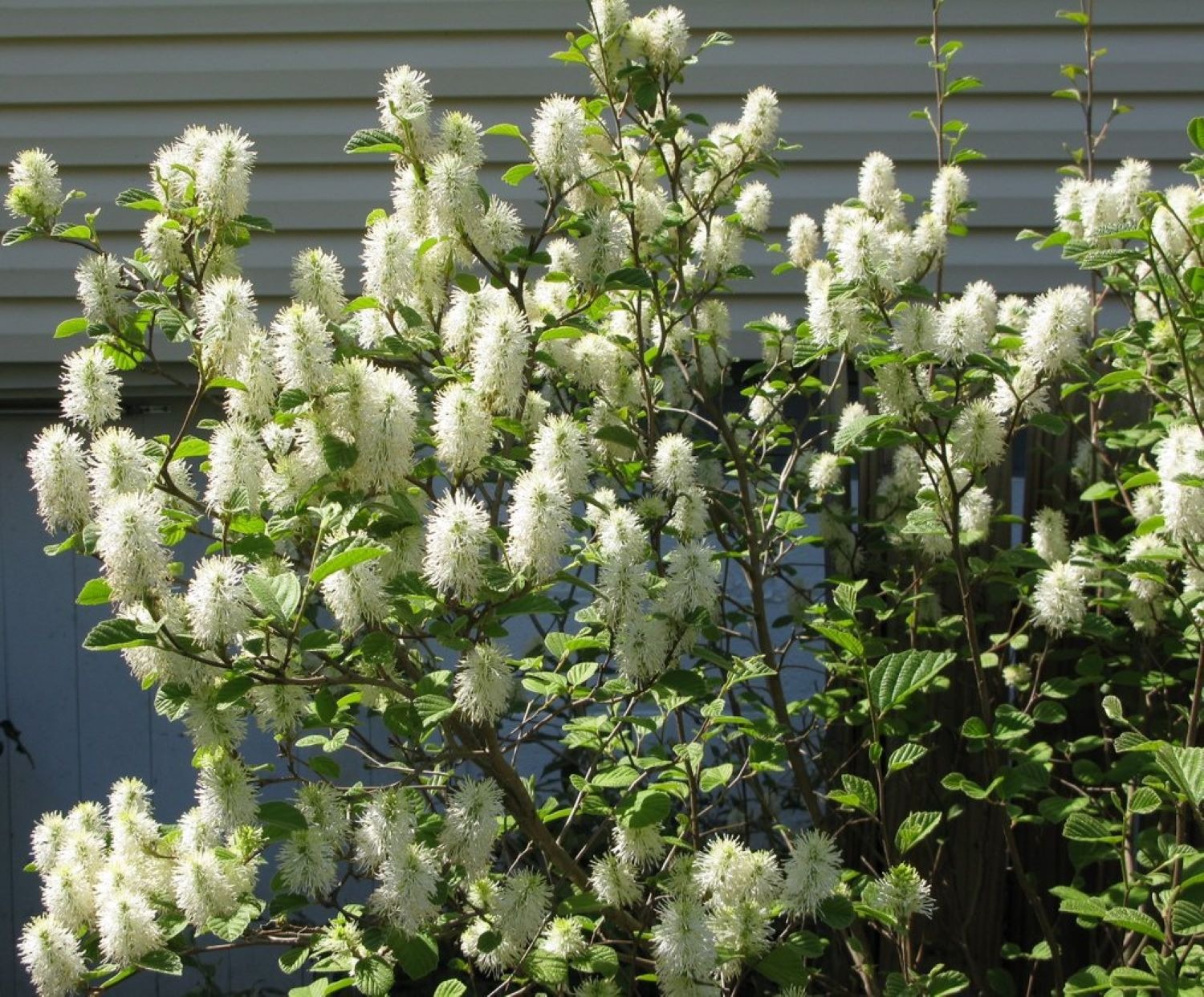
Fothergilla gardenii, also known as Dwarf Fothergilla, is a compact, slow-growing deciduous shrub native to the southeastern United States. It generally reaches 2 to 3 feet in height and width, making it perfect for small gardens or foundation plantings. The foliage is bluish-green in summer and turns brilliant shades of orange, red, and yellow in autumn.
In early to mid-spring, Dwarf Fothergilla produces fragrant, bottlebrush-like white flowers on bare stems, before the leaves emerge. These distinctive blooms are rich in nectar and attract early-season pollinators, especially native bees.
This shrub is hardy in USDA zones 5 through 8. It prefers well-drained, acidic soils and grows best in full sun to partial shade. Though slow to establish, it is long-lived and requires little maintenance beyond occasional shaping. It’s ideal for woodland borders, native plantings, and shaded mixed beds.
Rhododendron albiflorum (Whiteflower Rhododendron)
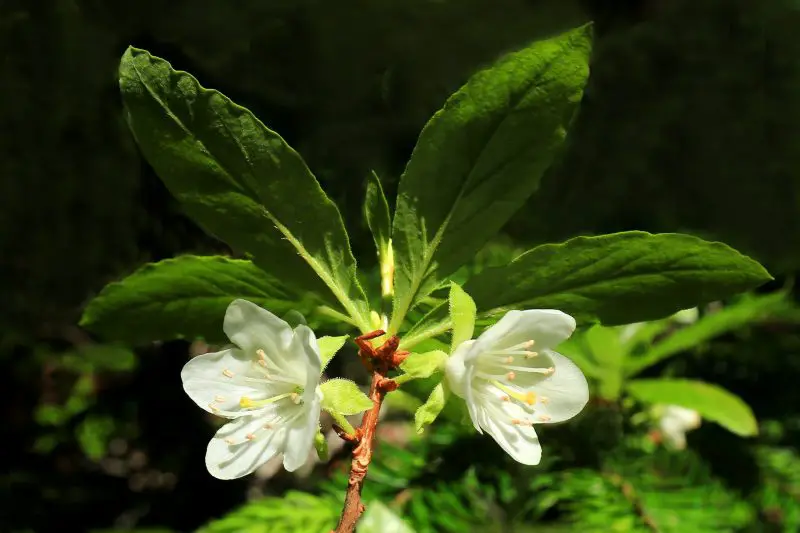
Rhododendron albiflorum, or Whiteflower Rhododendron, is a deciduous rhododendron species native to the mountainous regions of western North America, particularly the Pacific Northwest. It usually grows between 3 and 10 feet tall and features slender stems with oblong, soft green leaves that are lightly aromatic when crushed.
This rhododendron blooms in late spring to early summer, producing clusters of delicate white, bell-shaped flowers that hang gracefully from the ends of branches. Unlike most rhododendrons, it thrives in cooler, high-altitude environments and contributes to the floral diversity of montane forests.
Whiteflower Rhododendron is hardy in USDA zones 5 through 7. It prefers moist, acidic, well-drained soils and grows best in dappled shade. It’s an excellent choice for naturalized settings, woodland gardens, and areas with consistently cool summers. Care involves keeping roots moist and protected with mulch to mimic its native habitat.
Deutzia gracilis (Slender Deutzia)
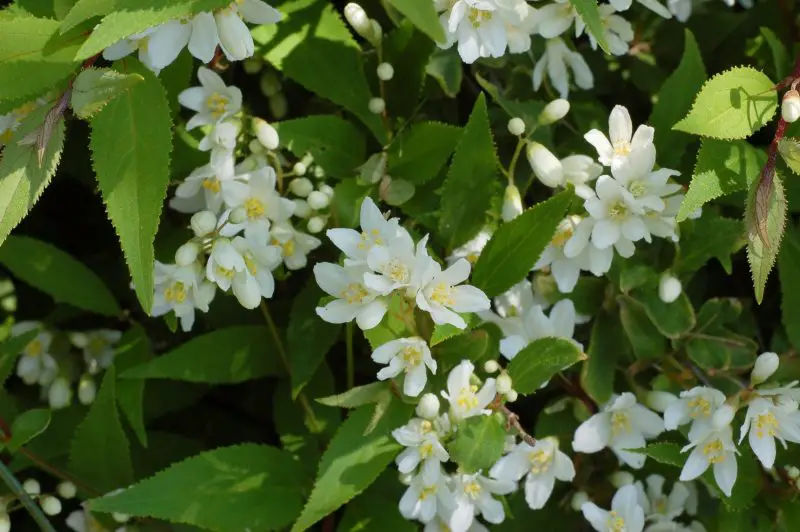
Deutzia gracilis, commonly known as Slender Deutzia, is a compact deciduous shrub that grows 2 to 4 feet tall and wide. Native to Japan, it features arching stems with narrow, pointed green leaves and a graceful, spreading form. This low-maintenance shrub is often used in borders, rock gardens, or as a mass planting.
In late spring to early summer, Slender Deutzia is covered in a profusion of star-shaped white flowers that form along the arching branches. These blossoms are lightly fragrant and attractive to pollinators, including bees and butterflies. Some cultivars offer added ornamental appeal with burgundy-tinted foliage in fall.
Hardy in USDA zones 5 through 8, Deutzia gracilis thrives in full sun to partial shade and prefers well-drained soils. It tolerates clay and urban conditions, and its compact habit makes it easy to maintain with light pruning after flowering. This shrub is prized for its showy blooms and reliable garden performance.
Exochorda racemosa (Pearlbush)
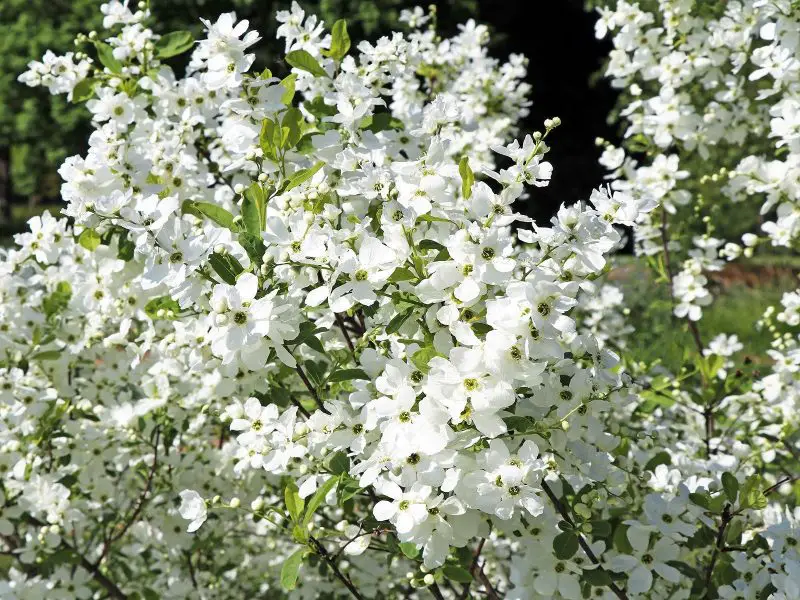
Exochorda racemosa, commonly called Pearlbush, is a deciduous shrub with a rounded shape that reaches 6 to 10 feet in height and width. Native to China, it features slender branches and oval, gray-green leaves that provide a soft texture in the landscape. It gets its name from the rounded flower buds that resemble strings of pearls.
In mid to late spring, Pearlbush bursts into bloom with clusters of pure white, five-petaled flowers that completely cover the arching stems. The show is brief but spectacular, and the plant draws attention as one of the earliest flowering shrubs in the season. It does not typically produce fruit.
This shrub is hardy in USDA zones 4 through 8. It prefers well-drained soils and full sun to partial shade, though flowering is more prolific with more sun exposure. Pearlbush benefits from light pruning after blooming to maintain its shape and encourage vigorous new growth. It’s an excellent accent or specimen plant for spring interest.
Ligustrum vulgare (Common Privet)
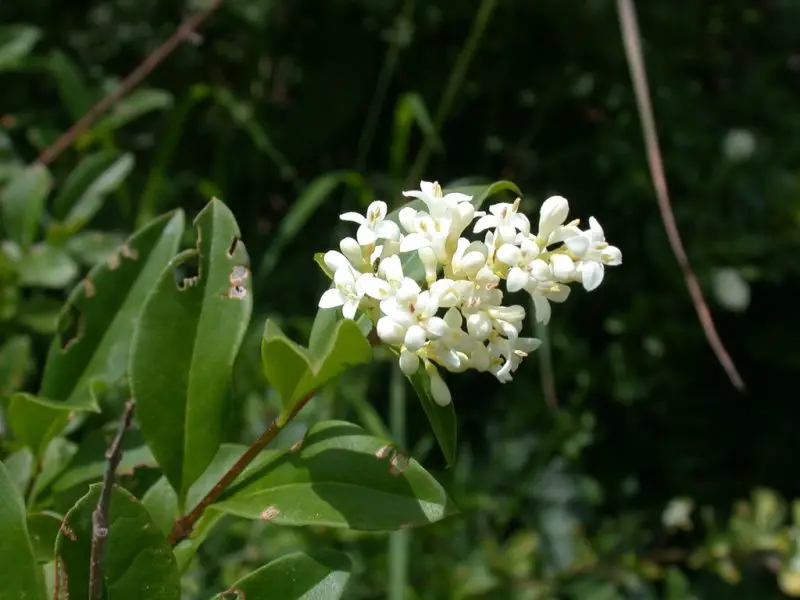
Ligustrum vulgare, commonly known as Common Privet, is a fast-growing deciduous to semi-evergreen shrub native to Europe but widely naturalized across North America. It typically grows between 8 and 15 feet tall and is frequently sheared into hedges due to its dense branching and small, glossy green leaves. This shrub is often used in formal landscapes, borders, and privacy screens.
In early to mid-summer, Common Privet produces clusters of small white flowers with a strong fragrance that some find unpleasant. Despite this, the flowers attract a variety of pollinators, including bees and butterflies. Following bloom, the plant sets small black berries that are toxic to humans but eaten by birds.
Hardy in USDA zones 4 through 7, Ligustrum vulgare thrives in full sun to partial shade and tolerates a wide range of soil conditions, including poor or dry soils. It benefits from regular pruning to maintain shape and prevent excessive spread. While useful as a hedge, it can become invasive in unmanaged areas, so care should be taken in natural landscapes.
Edgeworthia chrysantha ‘Nanjing Gold’ (Paperbush)

Edgeworthia chrysantha ‘Nanjing Gold’, or Paperbush, is a deciduous shrub known for its unique winter and early spring floral display. This variety features upright growth to about 4 to 6 feet tall and wide, with slender branches and broad, velvety green leaves that add a tropical look during the growing season. The leaves drop in autumn, revealing attractive cinnamon-colored stems.
In late winter to early spring, before the leaves emerge, Paperbush produces clusters of creamy white and yellow tubular flowers with a strong, sweet fragrance. The blossoms form at the tips of branches in spherical heads, resembling small pom-poms, and provide early nectar for pollinators.
Best suited to USDA zones 7 through 10, this shrub prefers rich, well-drained soils and thrives in partial shade. It requires protection from harsh winds and cold in cooler zones. Paperbush is an ideal specimen for woodland gardens or near walkways where its fragrance can be appreciated.
Sambucus canadensis (American Elderberry)
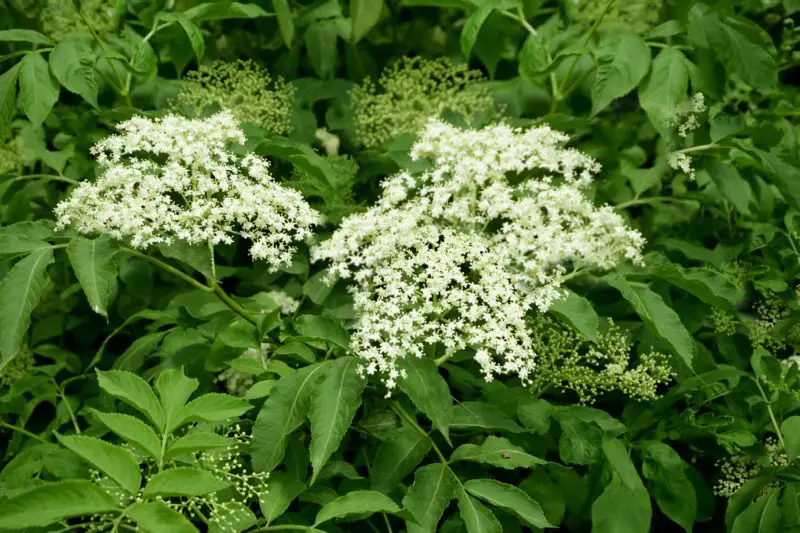
Sambucus canadensis, commonly known as American Elderberry, is a fast-growing deciduous shrub native to eastern and central North America. It typically reaches 5 to 12 feet in height and width, forming colonies with multiple stems. The leaves are pinnately compound and medium green, giving it a feathery, graceful appearance.
In early to midsummer, American Elderberry blooms with broad, flat-topped clusters of small white flowers. These blossoms are mildly fragrant and highly attractive to pollinators, especially bees and butterflies. The flowers give way to dark purple-black berries, which are used in jams, wines, and syrups when properly cooked.
Hardy in USDA zones 3 through 9, this shrub prefers moist, well-drained soils and full sun to partial shade. It is tolerant of wet conditions and makes an excellent choice for rain gardens, streambanks, or wildlife habitats. Pruning encourages better flowering and fruiting, and the plant spreads easily through suckers.
Rosa rugosa ‘Alba’ (White Rugosa Rose)
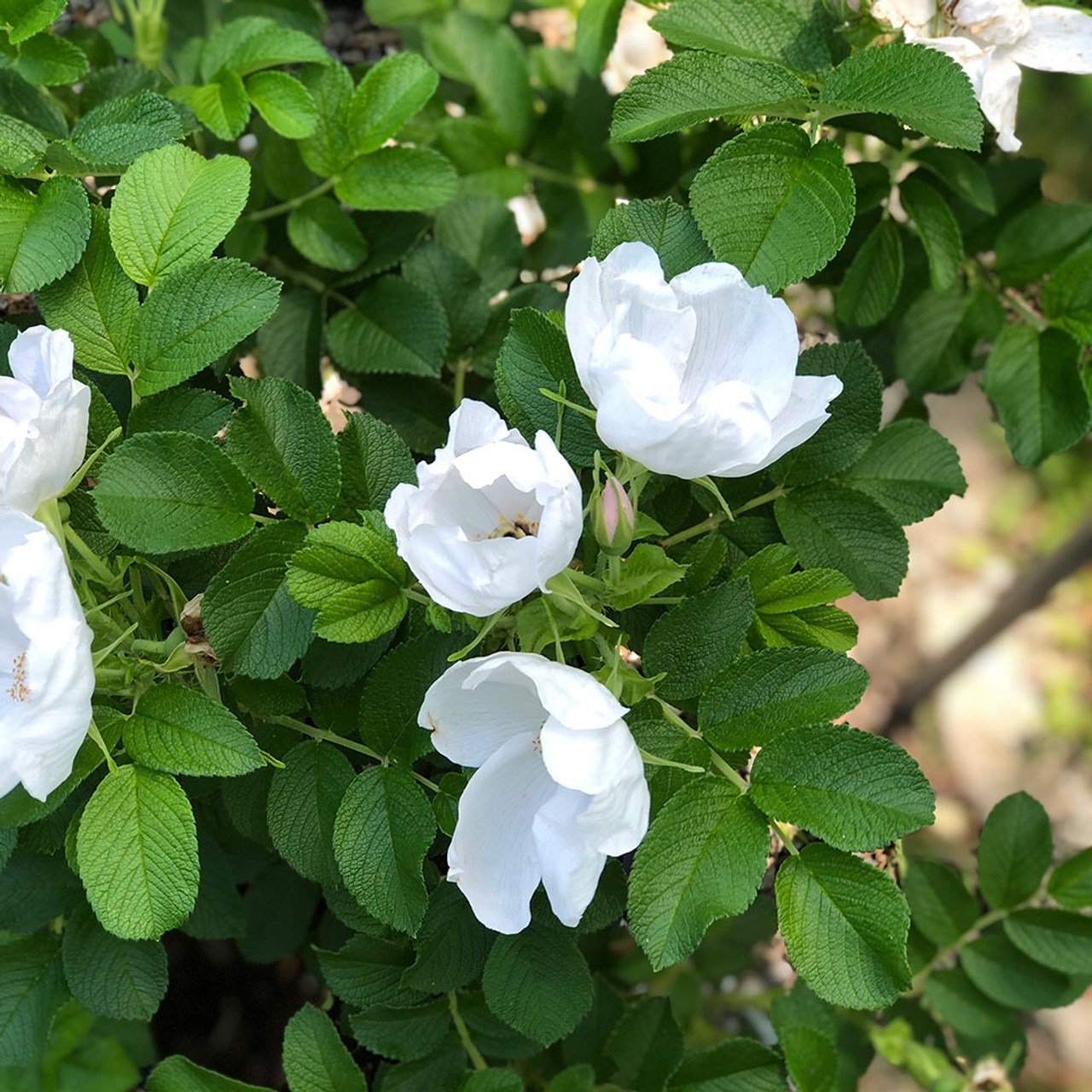
Rosa rugosa ‘Alba’ is a cultivar of the rugged and salt-tolerant Rugosa Rose, known for its pure white, fragrant blooms. Native to eastern Asia, this deciduous shrub forms a dense, thorny thicket of wrinkled, dark green leaves and can grow 4 to 6 feet tall and wide. Its robust nature makes it ideal for coastal gardens and erosion control.
The flowers appear from late spring through summer, often in repeating waves, and feature five crisp white petals with a strong, sweet scent. These are followed by large, bright orange-red hips that persist into winter, providing ornamental value and food for birds.
Hardy in USDA zones 2 through 7, this rose is exceptionally tolerant of poor soils, wind, and salt spray. It thrives in full sun and benefits from minimal pruning to remove dead wood and control size. Rosa rugosa ‘Alba’ is well-suited to informal hedges, mixed borders, or naturalized areas.
Rosa multiflora (Multiflora Rose)
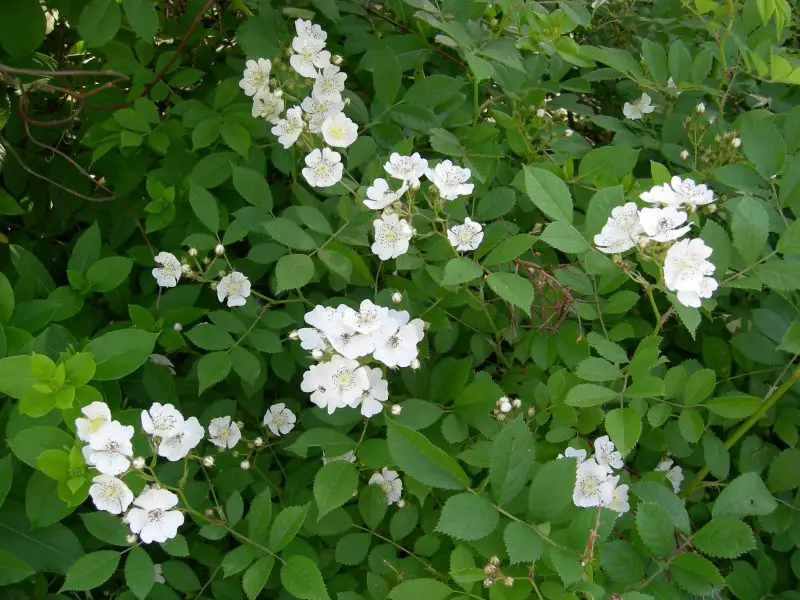
Rosa multiflora, or Multiflora Rose, is a vigorous, sprawling deciduous shrub originally from East Asia but now widely naturalized and often invasive in North America. It grows quickly to 10 feet or more, forming dense, arching thickets. The leaves are compound and finely toothed, and the plant is armed with curved thorns.
In late spring to early summer, this rose produces profuse clusters of small, white, five-petaled flowers with a light fragrance. These blooms attract a wide range of pollinators and are followed by small red hips that persist into winter. While beautiful in bloom, the plant often escapes cultivation and dominates native habitats.
Hardy in USDA zones 5 through 8, Multiflora Rose grows in a variety of soils and light conditions but thrives in sunny, open areas. Its invasive nature means it should not be planted in natural or unmanaged areas. In restoration contexts, removal or strict control is often necessary to protect native plant communities.
Caragana arborescens ‘Pendula’ (Weeping Siberian Peashrub)
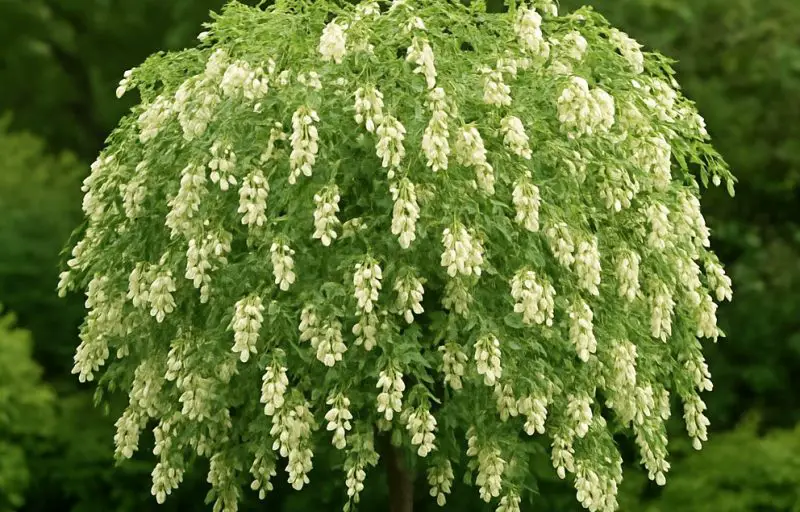
Caragana arborescens ‘Pendula’, known as Weeping Siberian Peashrub, is a small deciduous tree or large shrub with a unique pendulous growth habit. Native to Siberia and northern China, this cultivar is appreciated for its cascading branches and fine-textured foliage. While most commonly seen with yellow flowers, some white-flowering forms do exist and are occasionally available in specialty nurseries.
When blooming in late spring, the white flowers appear in small clusters along the weeping branches. They resemble pea blossoms, which is typical for members of the legume family. After flowering, small seed pods develop, adding subtle ornamental interest through summer.
Hardy in USDA zones 2 through 6, this cold-tolerant shrub prefers full sun and well-drained soils. It is drought-resistant once established and requires minimal maintenance. Pruning is generally limited to shaping or removing dead wood. Its distinctive shape makes it a good focal point in xeriscapes or rock gardens.
Spiraea nipponica ‘Snowmound’ (Snowmound Spirea)
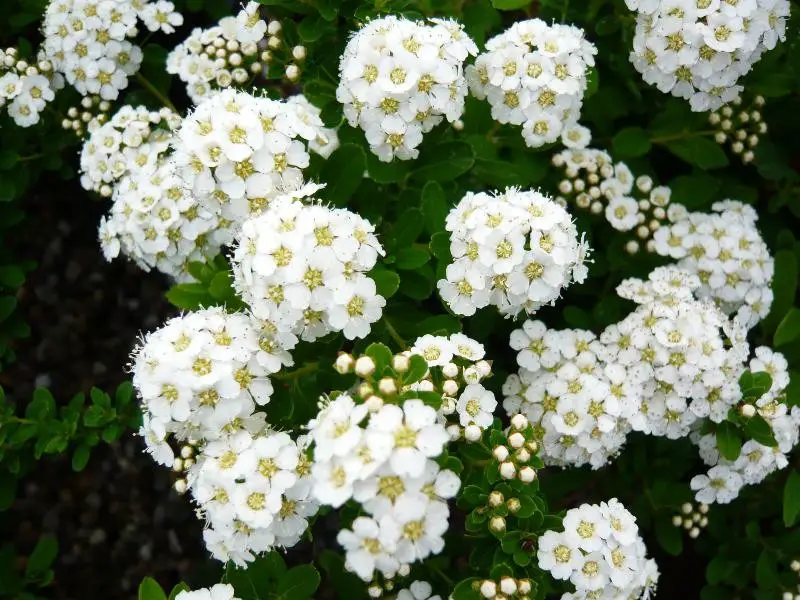
Spiraea nipponica ‘Snowmound’, commonly called Snowmound Spirea, is a compact deciduous shrub known for its profuse white blooms and tidy, mounded habit. It typically reaches 3 to 5 feet in height and width and is a favorite for low-maintenance borders and foundation plantings. The dark green, lance-shaped leaves provide a beautiful contrast to the flowers.
In late spring to early summer, Snowmound Spirea produces an abundance of small white flowers in arching clusters that completely cover the plant, giving it a “snow-covered” appearance. These blooms are attractive to pollinators and provide excellent early-season visual impact.
This shrub is hardy in USDA zones 4 through 8 and grows best in full sun with moderately moist, well-drained soil. It tolerates some drought once established and responds well to pruning right after flowering. Regular thinning can help maintain its shape and vigor over time.
Magnolia stellata (Star Magnolia)
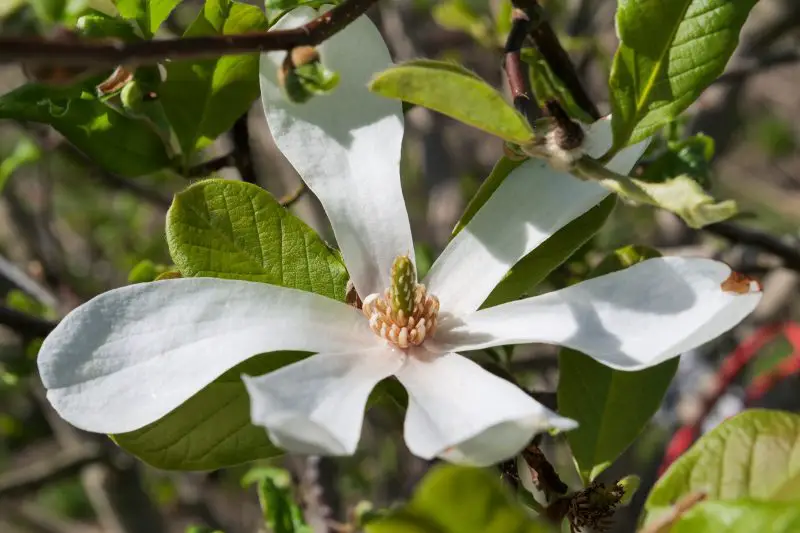
Magnolia stellata, or Star Magnolia, is a slow-growing deciduous shrub or small tree native to Japan. It is one of the earliest magnolias to bloom and is prized for its delicate, star-shaped white flowers that appear before the leaves emerge. This shrub typically reaches 10 to 15 feet in height with a rounded or multi-stemmed form.
The flowers bloom in very early spring, sometimes as early as March, depending on location. Each bloom has 12 to 18 slender white petals and a light, sweet fragrance. The display is showy and often a welcome sign of spring, although early frosts can damage the flowers in colder regions.
Hardy in USDA zones 4 through 8, Star Magnolia prefers full sun to partial shade and well-drained, slightly acidic soil. It appreciates consistent moisture but is not tolerant of waterlogged conditions. Pruning should be minimal and done after flowering to maintain a natural form.
Lonicera albiflora (White Honeysuckle)
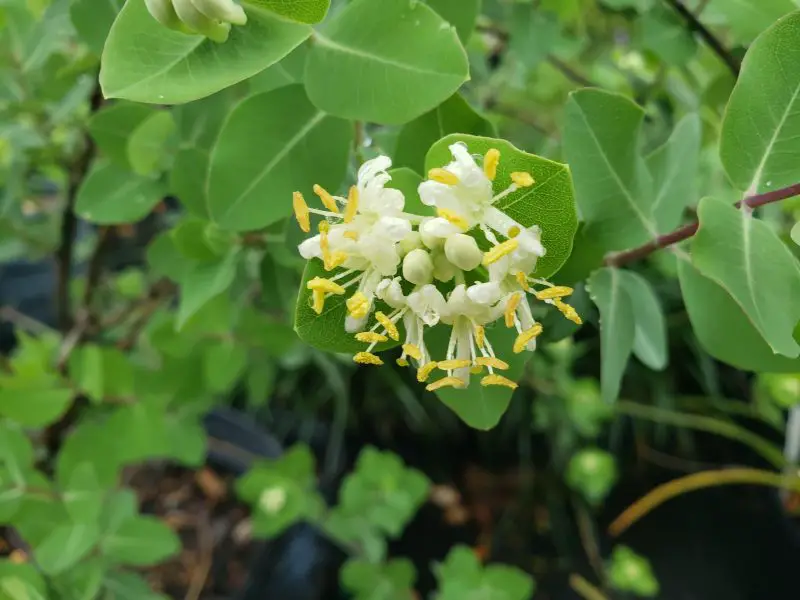
Lonicera albiflora, commonly known as White Honeysuckle, is a native twining or sprawling deciduous shrub found in parts of the southern and central United States. It is part of the honeysuckle family and valued for its fragrant, tubular white flowers that often turn creamy or pale yellow with age.
Flowering occurs from late spring into early summer. The blooms appear in pairs along the stems and are rich in nectar, attracting hummingbirds and pollinators. The flowers are followed by small red berries that are ornamental but not edible for humans.
Hardy in USDA zones 6 through 9, this honeysuckle thrives in well-drained soils with full sun to partial shade. It can be trained on trellises, fences, or allowed to sprawl in a naturalistic setting. Occasional pruning helps manage its shape and encourage more vigorous flowering.
Salix discolor (Pussy Willow)
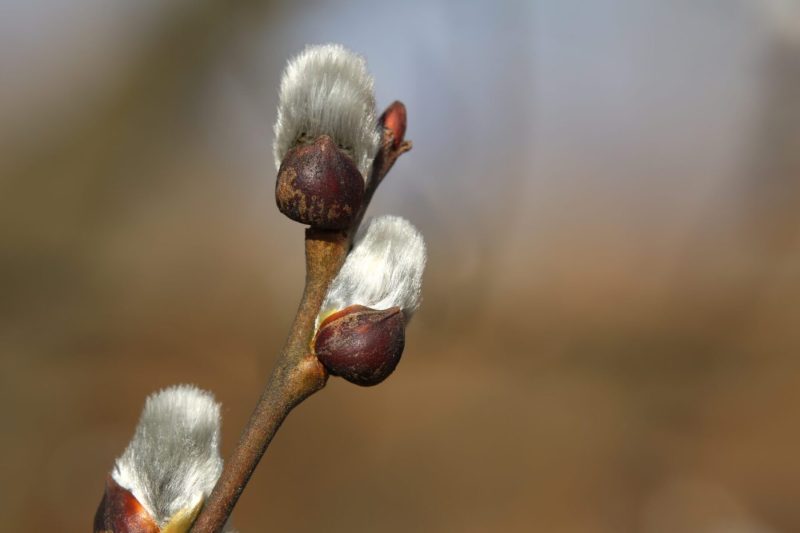
Salix discolor, commonly known as Pussy Willow, is a deciduous shrub or small tree native to northern and central North America. It typically grows 6 to 15 feet tall and is widely known for its soft, silvery-gray male catkins that appear in very early spring, often before the leaves.
The fuzzy catkins resemble tiny tufts of fur and are one of the first signs of spring in cold climates. As the season progresses, the male catkins may develop yellow pollen, while female catkins (on separate plants) elongate and become less showy. Pussy Willow is a popular ornamental for floral arrangements and wildlife gardens.
This species is hardy in USDA zones 4 through 8 and prefers moist, fertile soils in full sun to part shade. It is well-suited to wetland edges, rain gardens, and low areas. Prune after flowering to maintain shape and encourage fresh growth.






